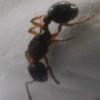I know in their own time, once they find a better place to live they will leave...
However they seem to be eating through the cotton bud that blocks the water on the other side.
I'm worried they'll chew through it and get flooded by the water.
I have no idea what they're doing to be honest, they've pulled a small chunk of it off and are putting sand on it, like they're trying to hide the eggs or something.
Are they smart enough to realize that they might unleash a huge torrent of water upon themselves or do I need to get them out?
If so, any ideas how? Getting tweezers and pulling them out doesn't sound very safe.
















